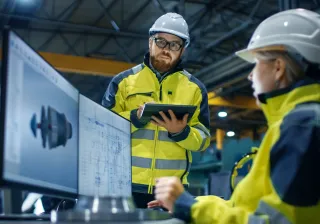VTT has been examining resilience from the perspective of the operation and growth of the manufacturing industry with the funding from the recovery package of the Minister of Economic Affairs and Employment. The aim has been to find solutions to how companies and entire value chains could operate more systematically on resilience issues, prepare better for unexpected situations, and reduce vulnerabilities both in their own activities and in entire supply networks.
In addition, efforts have been made to identify interesting new business opportunities related to exceptional situations, as well as situations where manufacturing could be returned to Finland. VTT has been promoting resilience in cooperation with the industry and developed tools for supporting companies. One of the tools developed is the resilience analysis tool, aimed at facilitating the identification of company-specific vulnerability risks and development targets. VTT has been testing the tool with companies and, as a result, identified development targets that clarify the company's situational picture.
Situational picture
Companies typically prepare for exceptional situations as part of the monitoring of their operating environment and their efforts aimed at securing the company's finances, continuity and overall security. Business continuity can be promoted by more comprehensive monitoring of the impacts of exceptional situations and drivers quickly, and in the short and long term. The success of the Finnish industry is based on highly advanced expertise and value chain cooperation. One of its clear strengths is the ability to react quickly in value chains in which the ‘express delivery model’ has been kept up to date.
In terms of securing production, disturbances in the material flow are a significant risk, especially in critical components. Other vulnerabilities identified in production include critical personal expertise and dependence on temporary agency labour.
With regard to companies' operating models, in exceptional situations companies tend to take reactive but rapid action. They often lack proactive operating models and lessons learned. For example, when it comes to securing product and service processes, virtual and remote technologies have been introduction as successful rapid responses, but, of course, they could be utilised in much more versatile ways as well. There is also room for improvement in value chain cooperation under the principals and cooperation between suppliers.
Which development targets have been identified?
In broad terms, for example the following have emerged as targets of development:
- Integrating emergency preparedness into the company's normal operations
- Working in the board of directors
- Management team meetings
- Strategy work, operational planning and risk analyses
- Operational activities, such as operational groups set up for emergency situations
- Taking a more systematic approach to the monitoring of the company’s operating environment
- Preparing for acquiring new customers under emergency conditions
- Preparing for ensuring adequate critical personnel resources
- Building a deputy system for critical job positions
- Reducing dependency on 1–2 suppliers only
- Enhancing the performance of product and service processes by using remote technologies
- Increasing welding automation to reduce labour availability problems
- Improving network adaptability in case of internet disruptions
- Expanding the supplier network and identifying supplier competences in closer detail
- Mapping alternative sources of supply
Manufacturing back to Finland?
The discussions brought up promising messages about the transfer of subcontracting work closer to Finland. In addition to responding to customer demand, suppliers may also take action themselves, as it may be possible that customers also return to using ‘old’ products in exceptional situations. Furthermore, the first analyses identified various groups of components that give the entire manufacturing industry a serious reason to consider in what way it might improve the availability of these components and possibly also their quality, delivery capacity and overall affordability if they could be manufactured closer to Finland or in Finland. For example, demanding castings and forgings could be this kind of high-level risk components. Challenges related to the availability of labour also emerged in a few companies, not only as a vulnerability issue but also as a serious obstacle to growth.
Finally, the development of resilience is part of the company's strategy and continuity planning, and enhanced resilience improves the operating conditions of companies in Finland. The most agile companies are also able to utilise the peak demand for products and services generated by exceptional situations.
Read more of the resilience analysis on our first blog post!






